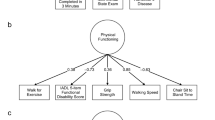Abstract:
The objectives of the study were: (1) to evaluate the contribution of impaired functional status, cognition and medication to fracture risk; (2) to determine whether risk factor profiles differ between regionally and socially diverse populations; and (3) to develop and validate a simple fracture prediction instrument for use in older adults using easily obtainable clinical information. A prospective population-based cohort study with 6–10 years of follow-up was carried out: the Duke and Iowa Established Populations for the Epidemiologic Study of the Elderly (EPESE), with in-person interviews in North Carolina and Iowa. The participants were community-dwelling men and women aged 65 years or over without a history of previous fracture at the baseline interview (n = 7654). The measurements were potential risk factors for osteoporosis and falls including: demographic factors, co-morbidities, medications, functional status measures, and physical measures. These were examined for association with self-reported subsequent hip fractures and fractures at any site using survival analysis. The resulting multivariable model was simplified and validated in a separate cohort. Test operating characteristics at 3 years were estimated using logistic regression. There were a total of 842 fractures in both cohorts including 382 hip fractures. Significant risk factors for all subsequent fractures and/or hip fracture in the developmental cohort included female sex (relative hazard 1.9–2.3), lowest quartile of body mass index (1.3), Caucasian race (2.1–2.8), one or more Rosow–Breslau physical function impairments (1.8–2.1), age over 75 years (2.1), history of stroke (1.9), cognitive impairment (2.2), one or more impairments in the activities of daily living (1.5) and anti-seizure medication use (2.0). Three predicitive models were highly significantly correlated with subsequent fractures with c-statistics in the developmental cohort at 3 and 6 years of 0.640–0.789. A simple count of risk factors had similar discriminative ability to the full model with a linear 35–65% increase in hazard of all fractures and hip fracture for each additional risk factor. In the validation cohort, the above variables were less potent predictors of fracture with only sex, body mass index and Rosow–Breslau impairment achieving significance. The predictive models including risk factor count remained significant in the validation set although the discriminative ability of the model was poor, with c-statistics of 0.574–0.749. Although there is no cut-point where fracture risk dramatically increases, patients can be counselled that there is a linear 77% increase in risk of hip fracture, and 29% increase in any fracture risk, with each additional risk factor they possess. Functional status impairment is an important predictor of fracture in older community-dwelling adults. The contribution of risk factors to fracture risk may differ between distinct populations.
Similar content being viewed by others
Author information
Authors and Affiliations
Additional information
Received: 28 January 2002 / Accepted: 8 July 2002
Rights and permissions
About this article
Cite this article
Colón-Emeric, C., Colón-Emeric, C., Pieper, C. et al. Can Historical and Functional Risk Factors be Used to Predict Fractures in Community-Dwelling Older Adults? Development and Validation of a Clinical Tool . Osteoporos Int 13, 955–961 (2002). https://doi.org/10.1007/s001980200133
Issue Date:
DOI: https://doi.org/10.1007/s001980200133




